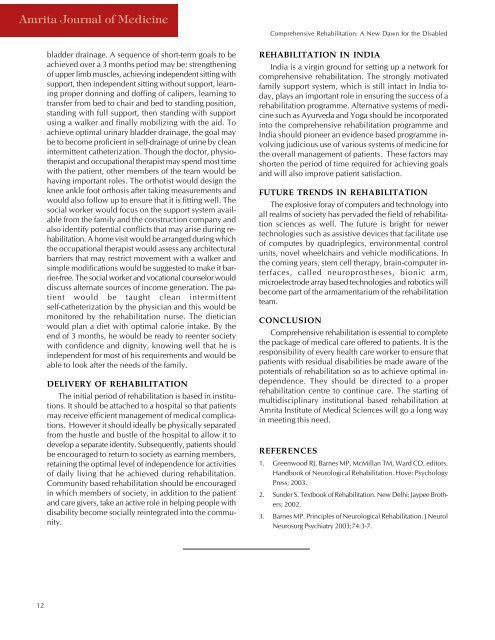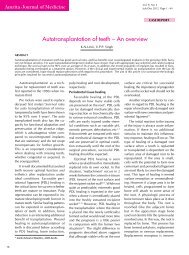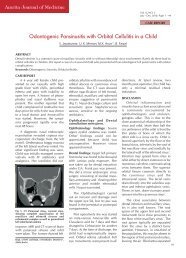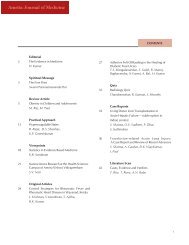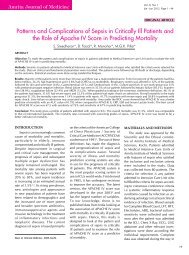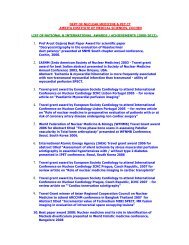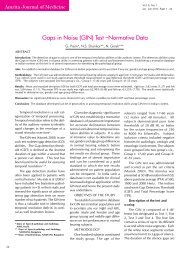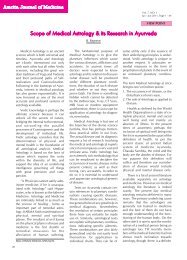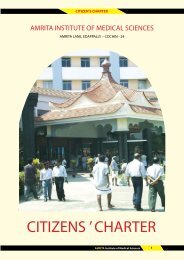Journal of Medicine Vol 4 - Amrita Institute of Medical Sciences and ...
Journal of Medicine Vol 4 - Amrita Institute of Medical Sciences and ...
Journal of Medicine Vol 4 - Amrita Institute of Medical Sciences and ...
Create successful ePaper yourself
Turn your PDF publications into a flip-book with our unique Google optimized e-Paper software.
<strong>Amrita</strong> <strong>Journal</strong> <strong>of</strong> <strong>Medicine</strong><br />
Comprehensive Rehabilitation: A New Dawn for the Disabled<br />
bladder drainage. A sequence <strong>of</strong> short-term goals to be<br />
achieved over a 3 months period may be: strengthening<br />
<strong>of</strong> upper limb muscles, achieving independent sitting with<br />
support, then independent sitting without support, learning<br />
proper donning <strong>and</strong> d<strong>of</strong>fing <strong>of</strong> calipers, learning to<br />
transfer from bed to chair <strong>and</strong> bed to st<strong>and</strong>ing position,<br />
st<strong>and</strong>ing with full support, then st<strong>and</strong>ing with support<br />
using a walker <strong>and</strong> finally mobilizing with the aid. To<br />
achieve optimal urinary bladder drainage, the goal may<br />
be to become pr<strong>of</strong>icient in self-drainage <strong>of</strong> urine by clean<br />
intermittent catheterization. Though the doctor, physiotherapist<br />
<strong>and</strong> occupational therapist may spend most time<br />
with the patient, other members <strong>of</strong> the team would be<br />
having important roles. The orthotist would design the<br />
knee ankle foot orthosis after taking measurements <strong>and</strong><br />
would also follow up to ensure that it is fitting well. The<br />
social worker would focus on the support system available<br />
from the family <strong>and</strong> the construction company <strong>and</strong><br />
also identify potential conflicts that may arise during rehabilitation.<br />
A home visit would be arranged during which<br />
the occupational therapist would assess any architectural<br />
barriers that may restrict movement with a walker <strong>and</strong><br />
simple modifications would be suggested to make it barrier-free.<br />
The social worker <strong>and</strong> vocational counselor would<br />
discuss alternate sources <strong>of</strong> income generation. The patient<br />
would be taught clean intermittent<br />
self-catheterization by the physician <strong>and</strong> this would be<br />
monitored by the rehabilitation nurse. The dietician<br />
would plan a diet with optimal calorie intake. By the<br />
end <strong>of</strong> 3 months, he would be ready to reenter society<br />
with confidence <strong>and</strong> dignity, knowing well that he is<br />
independent for most <strong>of</strong> his requirements <strong>and</strong> would be<br />
able to look after the needs <strong>of</strong> the family.<br />
DELIVERY OF REHABILITATION<br />
The initial period <strong>of</strong> rehabilitation is based in institutions.<br />
It should be attached to a hospital so that patients<br />
may receive efficient management <strong>of</strong> medical complications.<br />
However it should ideally be physically separated<br />
from the hustle <strong>and</strong> bustle <strong>of</strong> the hospital to allow it to<br />
develop a separate identity. Subsequently, patients should<br />
be encouraged to return to society as earning members,<br />
retaining the optimal level <strong>of</strong> independence for activities<br />
<strong>of</strong> daily living that he achieved during rehabilitation.<br />
Community based rehabilitation should be encouraged<br />
in which members <strong>of</strong> society, in addition to the patient<br />
<strong>and</strong> care givers, take an active role in helping people with<br />
disability become socially reintegrated into the community.<br />
REHABILITATION IN INDIA<br />
India is a virgin ground for setting up a network for<br />
comprehensive rehabilitation. The strongly motivated<br />
family support system, which is still intact in India today,<br />
plays an important role in ensuring the success <strong>of</strong> a<br />
rehabilitation programme. Alternative systems <strong>of</strong> medicine<br />
such as Ayurveda <strong>and</strong> Yoga should be incorporated<br />
into the comprehensive rehabilitation programme <strong>and</strong><br />
India should pioneer an evidence based programme involving<br />
judicious use <strong>of</strong> various systems <strong>of</strong> medicine for<br />
the overall management <strong>of</strong> patients. These factors may<br />
shorten the period <strong>of</strong> time required for achieving goals<br />
<strong>and</strong> will also improve patient satisfaction.<br />
FUTURE TRENDS IN REHABILITATION<br />
The explosive foray <strong>of</strong> computers <strong>and</strong> technology into<br />
all realms <strong>of</strong> society has pervaded the field <strong>of</strong> rehabilitation<br />
sciences as well. The future is bright for newer<br />
technologies such as assistive devices that facilitate use<br />
<strong>of</strong> computes by quadriplegics, environmental control<br />
units, novel wheelchairs <strong>and</strong> vehicle modifications. In<br />
the coming years, stem cell therapy, brain-computer interfaces,<br />
called neuroprostheses, bionic arm,<br />
microelectrode array based technologies <strong>and</strong> robotics will<br />
become part <strong>of</strong> the armamentarium <strong>of</strong> the rehabilitation<br />
team.<br />
CONCLUSION<br />
Comprehensive rehabilitation is essential to complete<br />
the package <strong>of</strong> medical care <strong>of</strong>fered to patients. It is the<br />
responsibility <strong>of</strong> every health care worker to ensure that<br />
patients with residual disabilities be made aware <strong>of</strong> the<br />
potentials <strong>of</strong> rehabilitation so as to achieve optimal independence.<br />
They should be directed to a proper<br />
rehabilitation centre to continue care. The starting <strong>of</strong><br />
multidisciplinary institutional based rehabilitation at<br />
<strong>Amrita</strong> <strong>Institute</strong> <strong>of</strong> <strong>Medical</strong> <strong>Sciences</strong> will go a long way<br />
in meeting this need.<br />
REFERENCES<br />
1. Greenwood RJ, Barnes MP, McMillan TM, Ward CD, editors.<br />
H<strong>and</strong>book <strong>of</strong> Neurological Rehabilitation. Hove: Psychology<br />
Press; 2003.<br />
2. Sunder S. Textbook <strong>of</strong> Rehabilitation. New Delhi: Jaypee Brothers;<br />
2002.<br />
3. Barnes MP. Principles <strong>of</strong> Neurological Rehabilitation. J Neurol<br />
Neurosurg Psychiatry 2003;74:3-7.<br />
12


